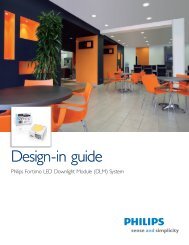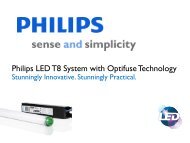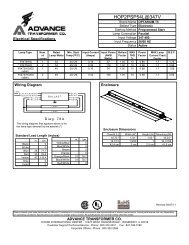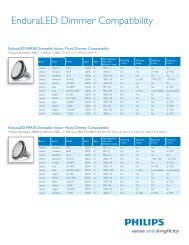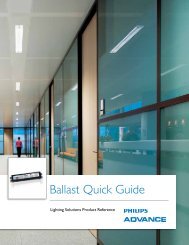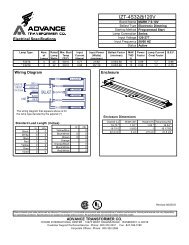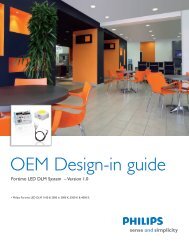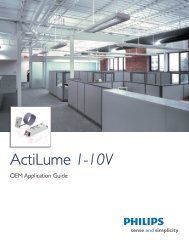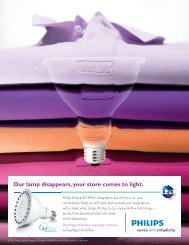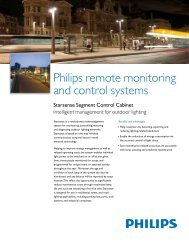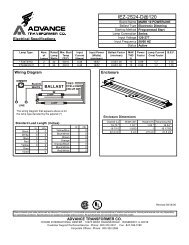Philips QL Induction Lighting Systems - Philips Lighting
Philips QL Induction Lighting Systems - Philips Lighting
Philips QL Induction Lighting Systems - Philips Lighting
- No tags were found...
You also want an ePaper? Increase the reach of your titles
YUMPU automatically turns print PDFs into web optimized ePapers that Google loves.
Surge test at max case<br />
temperature. 4x5 pulses.<br />
Light flicker max 3<br />
seconds is allowed above<br />
1kV surges.<br />
Mains Voltage Dips. To be<br />
tested at max case temp.<br />
Mains Voltage Interrupt.<br />
To be tested at max case<br />
temp.<br />
ESD discharge test:<br />
Contact and air discharge.<br />
Mains transient<br />
EN 61000-4-5 test level 4,<br />
requirement 4kV Line to Earth,<br />
2kV Line to Line<br />
EN 61000-4-11 70% of rated<br />
mains, 200ms<br />
EN 61000-4-11 0% of rated<br />
mains, 5ms. Execute test with<br />
pos. and neg. half cycle.<br />
EN 61547 clause 5.2<br />
ANSI/IEEE C62.41, 7 strikes<br />
Ringing Wave 100kHz, minimum<br />
2.5kV TBD<br />
Safety K123-1<br />
EN61347-2-3<br />
UL935<br />
Approbations<br />
CE, UL, CSA,<br />
KEMA (HV)<br />
Environmental conditions<br />
Humidity IEC 60068-2-30-Db 40°C 21<br />
days cyclic operative 2hrs on, 10<br />
hrs off. In conformity with UN-<br />
D1639-1 table2.3.5, "protected<br />
outdoor use": 10-95%RH.<br />
Vibration<br />
Bumps<br />
Shock test<br />
IEC 60068-2-6-Fc Frequency<br />
range 10-150Hz, Frequency<br />
change 1 oct/min<br />
Acceleration/amplitude<br />
2G/0.15mm peak, 3 directions,<br />
test time 40 min per direction.<br />
IEC 60068-2-29-Eb Acceleration<br />
10G Number of bumps 1000<br />
/16ms 3 directions.<br />
IEC 60068-2-27 40G / 11ms<br />
(semi sinusoidal), 3 directions, 5<br />
shocks per direction.<br />
The <strong>Philips</strong> <strong>QL</strong> lamp system carries the CE marking on basis<br />
of fulfillment of the following standards: EN 61547, EN<br />
61000-3-2 and EN 55015 (as tested in a <strong>Philips</strong> reference<br />
luminaire).<br />
6.5 IP codes; dust and moisture protection<br />
The <strong>QL</strong> lamp system is designed for built-in purposes in<br />
appropriate luminaires. Next to effective temperature control,<br />
the luminaire must also provide dust and moisture<br />
protection, especially for the HF generator part and the<br />
power coupler. Direct water intrusion or a high humidity<br />
causing condensation inside the HF generator and power<br />
coupler should be prevented, as should heavy dust<br />
accumulation. In practice, this means that <strong>QL</strong> luminaires<br />
applied in outdoor applications should be at least classified<br />
as IP 54.<br />
The HF generators for the <strong>QL</strong> 55W, 85W and 165W lamp<br />
systems are classified as IP 40.<br />
6.6 Dimming<br />
At present <strong>QL</strong> lamp systems are not available with dimming<br />
facilities.<br />
6.7 Lamp system disposal<br />
At the end of their (economic) life, appropriate disposal of <strong>QL</strong><br />
lamp systems or their components is recommended.<br />
6.7.1 The lamp<br />
Although only a very small mercury dose is used, it is still<br />
recommended to treat the lamp system part as small<br />
chemical waste. The <strong>QL</strong> lamp can very well be recycled<br />
together with other low-pressure mercury discharge lamps.<br />
Follow local regulations for disposal of this type of light<br />
source.<br />
6.7.2 The power coupler<br />
Due to the fact that no materials are used in the construction<br />
of this part, which at present are known to be harmful to the<br />
environment, this part can be disposed of as normal waste.<br />
Disassembling is relatively easy, so recycling of materials is<br />
also possible.<br />
6.7.3 The HF generator<br />
This component is a RoHS compliant electronic device,<br />
which can be disposed of with normal care. It is<br />
recommended to dispose of this part as normal electronic<br />
waste, according to local regulations.<br />
Temperature shock<br />
IEC 60068-2-14-Na 5 cycles<br />
-40°C/+80°C 30 min 2 chamber<br />
method cycle.<br />
IEC 60068-2-14-Nb -20°C/100°C<br />
2000 cycles. (TBF)<br />
24



